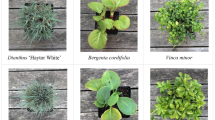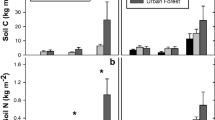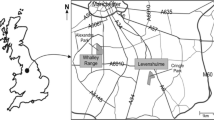Abstract
We assessed how small patches of contrasting urban ground cover [mesiscape (turf), xeriscape (gravel), concrete, and asphalt] altered the microclimate and performance of adjacent oleander (Nerium oleander L.) plants in Phoenix, Arizona during fall/winter (September–February) and spring/summer (March–September). Ground-cover and oleander canopy surface temperatures, canopy air temperatures and pot soil temperatures tended to be lowest in the mesiscape and highest in the asphalt and concrete. Canopy air vapor pressure deficits were lowest in the mesiscape and highest in the asphalt plot. Rates of net photosynthesis of all oleander plants were highest in October and May, and declined through mid-summer (June–July), when rates tended to be highest in the cooler mesiscape, particularly when water was limiting. During fall/winter, oleanders in the mesiscape produced 20% less biomass, 13% less leaf area, and had 12% lower relative growth rates (RG) than those in the other ground covers. Lower nighttime temperatures in the mesiscape in December led to oleander frost damage. During spring/summer, oleanders in the mesiscape produced 11% more biomass, 16% more leaf area, and had 3% higher RG than those in the other cover types. The effects of urban ground cover on oleander performance were season-specific; while oleander growth was greatest in the mesiscape during spring/summer, it was lowest during fall/winter and these plants experienced frost damage. Because all oleander plants produced >10 times as much biomass during the spring/summer, on an annual basis oleanders in the mesiscape produced 5–11% more biomass than plants in the warmer ground covers.







Similar content being viewed by others
References
Asaeda T, Ca VT, Wake A (1996) Heat storage of pavement and its effect on the lower atmosphere. Atmos Environ 30:413–427
Avissar R (1996) Potential effects of vegetation on the urban thermal environment. Atmos Environ 30:437–448
Badger MR, Björkman O, Armond PA (1982) An analysis of photosynthetic response and adaptation to temperature in higher plants: temperature acclimation in the desert evergreen Nerium oleander L. Plant Cell Environ 5:85–99
Balling RC (1992) The heated debate: greenhouse predictions versus climate reality. Pacific Research Institute for Public Policy, San Francisco
Balling RC, Brazel SW (1986) Temporal analysis of summertime weather stress levels in Phoenix, Arizona. Arch Meteorol Geophys Bioclimatol Ser B 36:331–342
Balling RC, Brazel SW (1988) High resolution surface temperature patterns in a complex urban terrain. Photogramm Eng Remote Sens 54:1289–1293
Balling RC, Brazel SW (1989) High-resolution nighttime temperature patterns in Phoenix. J Arizona-Nevada Acad Sci 23:49–53
Balling RC, Lolk NK (1991) A developing cool island in the desert? The case of Palm Springs, California. J Arizona-Nevada Acad Sci 23:93–96
Barradas VL, Tejada-Martínez A, Jáuregui E (1999) Energy balance measurements in a suburban vegetated area in Mexico City. Atmos Environ 33:4109–4113
Barradas VL (2000) Energy balance and transpiration in an urban tree hedgerow in Mexico City. Urban Ecosys 4:55–67
Björkman O, Downton WJS, Mooney HA (1980) Response and adaptation to water stress in Nerium oleander. Carnegie Inst Yearbook 79:150–157
Brazel SW, Selover N, Vose R, Heisler G (2000) The tale of two climates – Baltimore and Phoenix urban LTER sties. Climate Res 15:123–135
Brown PW (2000) AZMET Computation of reference crop evapotranspiration. (Arizona Meteorological Network web site) http://ag.arizona.edu/azmet/et2.htm
Bunce JA (1997) Variation in growth stimulation by elevated carbon dioxide in seedlings of some C3 crop and weed species. Global Change Biol 3:61–66
Campbell GS, Norman JM (1998) Introduction to environmental biophysics. Springer, Berlin Heidelberg New York
Cornelissen JHC, Castro Diez P, Hunt R (1996) Seedling growth, allocation and leaf attributes in a wide range of woody plant species and types. J Ecol 84:755–765
Day TA, Gober P, Xiong FS, Wentz EA (2002) Temporal patterns in near-surface CO2 concentrations over contrasting vegetation types in the Phoenix metropolitan area. Agric For Meteorol 110:229–245
de Valpine P, Harte J (2001) Plant responses to experimental warming in a montane meadow. Ecology 82:637–648
Evans GC (1972) The quantitative analysis of plant growth. Blackwell Scientific, Oxford, UK
Ferrar PJ, Slatyer RO, Vranjic JA (1989) Photosynthetic temperature acclimation in Eucalyptus species from diverse habitats, and a comparison with Nerium oleander. Aust J Plant Physiol 16:199–217
Goward SN (1981) Thermal behavior of urban landscapes and the urban heat island. Phys Geogr 2:19–33
Grace J (1988) Temperature as a determinant of plant productivity. In: Long SP, Woodward FI (eds) Plants and temperature. Cambridge University Press, Cambridge, pp 91–107
Graves WR, Dana MN (1987) Root-zone temperature monitored at urban sites. HortScience 22:613–614
Honjo T, Takakura T (1991) Simulation of thermal effects of urban green areas on their surrounding areas. Energy Build 15/16:443–446
Hunt R (1990) Basic growth analysis. Unwin Hyman, London, UK
Kjelgren RK, Clark JR (1992) Microclimates and tree growth in three urban spaces. J Environ Hortic 10:139–145
Kjelgren RK, Montague T (1998) Urban tree transpiration over turf and asphalt surfaces. Atmos Environ 32:35–41
Lambers H, Poorter H, Van Vuren MMI (1998) Inherent variation in plant growth. Backhuys, Leiden, Netherlands
Lu J, Arya SP, Snyder WH, Lawson RE (1997) A laboratory study of the urban heat island in a calm and stably stratified environment. I. Temperature field. J Appl Meteorol 36:1377–1391
Magee N, Curtis J, Wendler G (1999) The urban heat island effect at Fairbanks, Alaska. Theor Appl Climatol 64:39–47
McPherson EG (1994) Cooling urban heat islands with sustainable landscapes. In: Platt R, Rowntree R, Muick P (eds) The ecological city: preserving and restoring urban biodiversity. University of Massachusetts Press, Amherst, pp 151–171
Montague T, Kjelgren R, Rupp L (1998) Surface energy balance affects gas exchange of three shrub species. J Arboric 24:254–262
Montague T, Kjelgren R, Rupp L (2000) Surface energy balance affects gas exchange and growth of two irrigated landscape tree species in an arid climate. J Am Soc Hortic Sci 125:299–309
Pagen FJJ (1988) Oleanders: Nerium L. and the oleander cultivars. Agricultural University Wageningen, The Netherlands
Poorter H, Remkes C (1990) Leaf area ratio and net assimilation rate of 24 wild species differing in relative growth rate. Oecologia 83:553–559
Raison JK, Pike CS, Berry JA (1982) Growth temperature-induced alterations in the thermotropic properties of Nerium oleander membrane lipids. Plant Physiol 70:215–218
Saito I, Ishihara O, Katayama T (1991) Study of the effect of green areas on the thermal environment in an urban area. Energy Build 15/16:493–498
SAS (1999) SAT/STAT User’s guide. Version 8. SAS Institute, Cary, North Carolina
Schmidli RJ (1996) Climate of Phoenix, AZ: An abridged on-line version of NOAA technical memorandum NWS WR-177. Weather Service Forecast Office, Phoenix, AZ. http://geography.asu.edu/cerveny/phxwx.htm
SigmaPlot (2002) SigmaPlot for windows. Version 8.0. SPSS, Chicago, Ill.
Taha H, Akbari H, Rosenfeld A (1991) Heat island and oasis effects of vegetative canopies: Micro-meteorological field-measurements. Theor Appl Climatol 44:123–138
U.S. Census Bureau (1998) United States Department of Commerce, Washington, D.C.
Yamashita S (1996) Detailed structure of heat island phenomena from moving observations from electric tram-cars in metropolitan Tokyo. Atmos Environ 30:429–435
Xiong FS, Mueller EC, Day TA (2000) Photosynthetic and respiratory acclimation and growth response of Antarctic vascular plants to contrasting temperature regimes. Am J Bot 87:700–710
Zajicek JM, Heilman JL (1991) Transpiration by crape myrtle cultivars surrounded by mulch, soil, and turfgrass surfaces. HortScience 26:1207–1210
Acknowledgements
We thank S. Wightman, J. Gallaher, J. Vannett and E. Foley for field assistance, and Duane Ray Architects, Rolands-Cox Construction, Desert Tree Farm, Brooks Turf, and Desert Composting for donating time and supplies. Drs. C. Martin and S. Szarek provided useful comments on this manuscript. Partial support for this project was provided by the National Science Foundation under grant DEB-9714833, Central Arizona-Phoenix, Long-Term Ecological Research (CAP LTER)
Author information
Authors and Affiliations
Corresponding author
Rights and permissions
About this article
Cite this article
Mueller, E.C., Day, T.A. The effect of urban ground cover on microclimate, growth and leaf gas exchange of oleander in Phoenix, Arizona. Int J Biometeorol 49, 244–255 (2005). https://doi.org/10.1007/s00484-004-0235-1
Received:
Revised:
Accepted:
Published:
Issue Date:
DOI: https://doi.org/10.1007/s00484-004-0235-1




